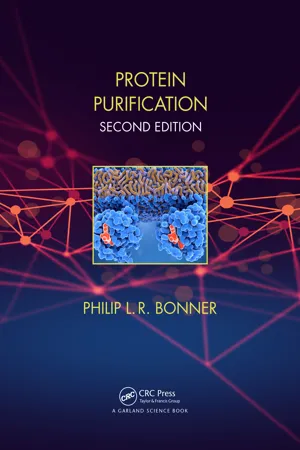
- 18 pages
- English
- ePUB (mobile friendly)
- Available on iOS & Android
Protein Purification
About This Book
This second edition of Protein Purification provides a guide to the major chromatographic techniques, including non-affinity absorption techniques, affinity procedures, non-absorption techniques and methods for monitoring protein purity. The new edition of the book has been organized to encourage incremental learning about the topic, starting with the properties of water, progressing through the characteristics of amino acids and proteins which relate to the purification process. There is an overview of protein strategy and equipment, followed by discussions and examples of each technique and their applications.
The basic theory and simple explanations given in Protein Purification make it an ideal handbook for final year undergraduates, and postgraduates, who are conducting research projects. It will also be a useful guide to more experienced researchers who need a good overview of the techniques and products used in protein purification.
Key Features
* Guide to the major techniques used in protein purification
* Includes flowcharts to help the reader slect the best purification strategy
* Contains step-by-step protocols that guide the reader through each technique and its use
* Includes exercises and solutions
Frequently asked questions
Information
1Water, pH and Buffers
1.1Introduction
Table of contents
- Cover
- Half Title Page
- Series Page
- Title Page
- Copyright Page
- Contents
- Detailed Contents
- Preface
- Abbreviations
- Chapter 1 Water, pH and Buffers
- Chapter 2 Protein Structure and Properties
- Chapter 3 Chromatography and the Strategy of Protein Purification
- Chapter 4 The Groundwork
- Chapter 5 Non-Affinity Absorption Techniques Used to Purify Proteins
- Chapter 6 Affinity-Based Procedures Used to Purify Proteins
- Chapter 7 Non-Absorption Techniques for Purifying Proteins
- Chapter 8 Methods for Monitoring the Purity of Protein Solutions
- Appendix 1 The Laws of Thermodynamics and the Gibbs Free Energy Equation
- Appendix 2 Properties of Amino Acids
- Appendix 3 The Common Units Used in Biology
- Appendix 4 Chromatographic Runs
- Appendix 5 Determining the Concentration of a Compound in a Solution in ppm
- Appendix 6 The Answers to the Exercises in the Various Chapters
- Appendix 7 An Alphabetical List of Chromatography (C), Electrophoresis (E), Filtration Equipment (F) and Laboratory Suppliers (LS)
- Appendix 8 Buffer Tables to Prepare Buffers at a Required pH Value
- Glossary of Terms
- Index